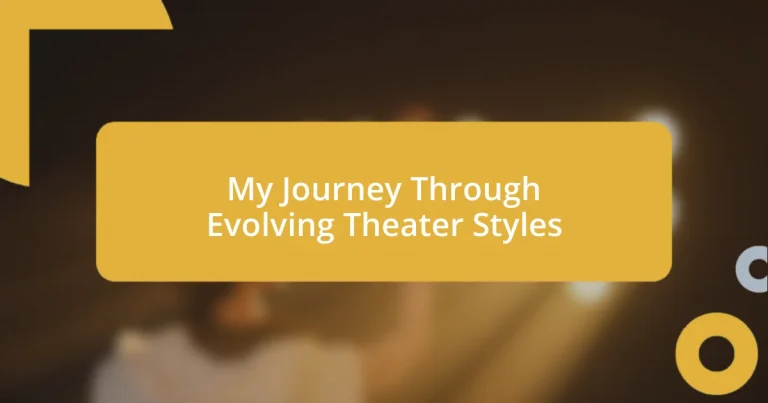Key takeaways:
- The evolution of theater is shaped by cultural shifts, technological advancements, and diverse voices, reflecting societal values and challenges throughout history.
- Modern theater incorporates immersive experiences, multimedia elements, and social justice themes, engaging audiences in new ways and encouraging discussions on real-world issues.
- Future theater arts may see a greater integration of technology, an emphasis on sustainability, and more community-centered performances, redefining audience participation and storytelling.
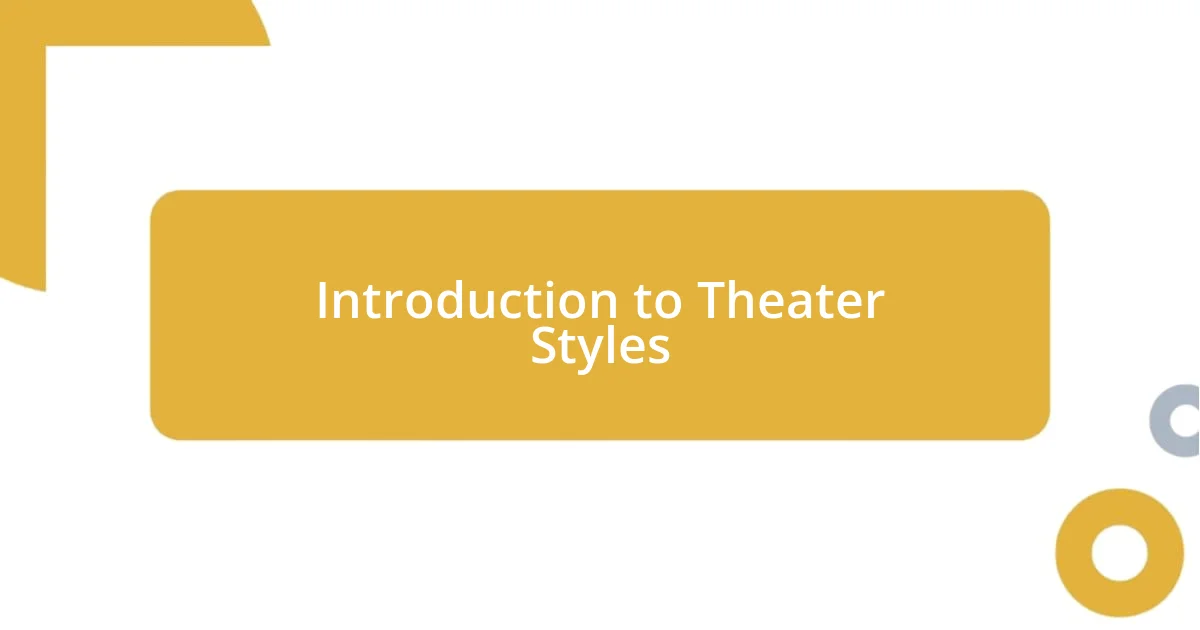
Introduction to Theater Styles
Theater styles are like a palette of colors for an artist; each one brings its own unique flair, emotion, and storytelling technique. I remember the first time I experienced a vibrant musical, where the energy and passion of the performers swept me off my feet. It got me thinking: what makes a particular style resonate so deeply with us?
Different styles, such as realism, absurdism, and classical theater, shape the way we perceive and engage with stories. Personally, I’ve always been drawn to the raw, emotional power of realism—it has this uncanny ability to reflect our everyday struggles. Have you ever watched a play that felt like it was peeling back the layers of your own life?
As I reflect on my journey through these styles, I realize how profoundly each one can influence our understanding of human experiences. Exploring these various approaches doesn’t just deepen our appreciation for theater; it allows us to connect with our own emotions and the world around us. Isn’t that what makes theater truly magical?
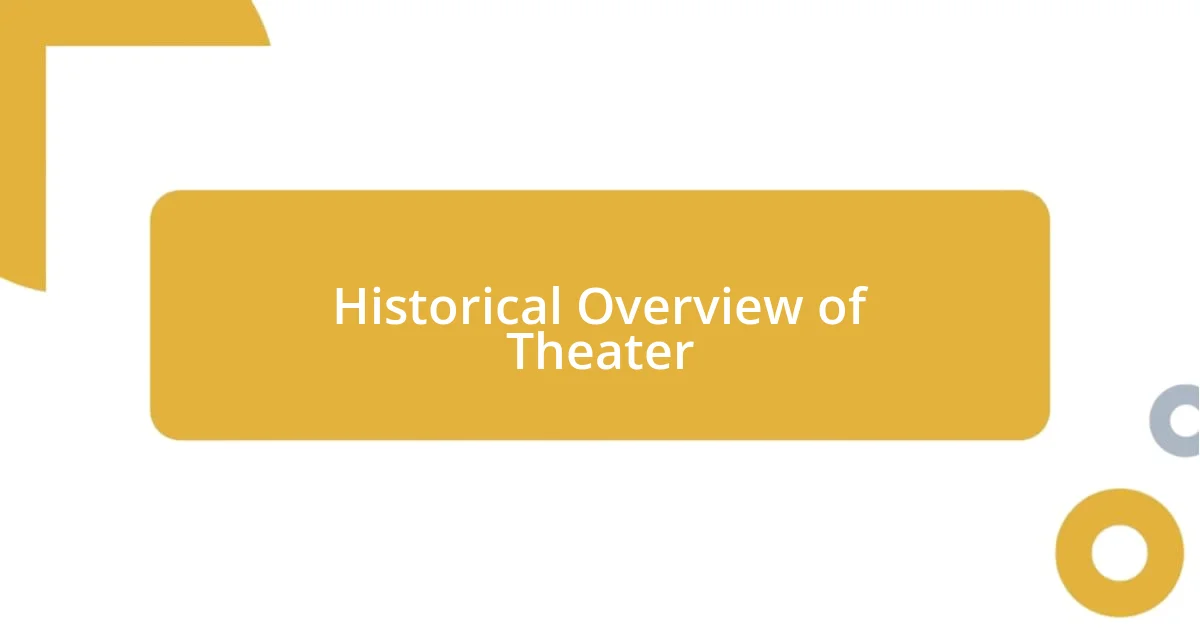
Historical Overview of Theater
The history of theater stretches back thousands of years, evolving in tandem with culture and society. I recall a school trip to an ancient theater where I stood amidst ruins, feeling the weight of history in the air; it sparked my curiosity about how these spaces were once filled with laughter, drama, and powerful storytelling. Each era brought its own innovations, from the Greek tragedies that explored human suffering to the Renaissance’s revival of classical themes and aesthetics.
Key milestones in theater history include:
– Ancient Greece: Birthplace of Western theater, emphasizing tragedy and comedy.
– Medieval Period: Introduction of morality plays that taught spiritual lessons.
– Renaissance: The rebirth of classical ideas, leading to the works of Shakespeare and Marlowe.
– 19th Century: The rise of realism, highlighting everyday life and societal issues.
– Modern Era: The explosion of diverse styles, including absurdism and experimental theater, revealing the complexities of human existence.
Reflecting on these milestones, I often find myself thinking about how the challenges faced by each generation are expressed through theater. The stories told in each of these periods resonate with our struggles, offering both a mirror and a comfort as we navigate our own lives.
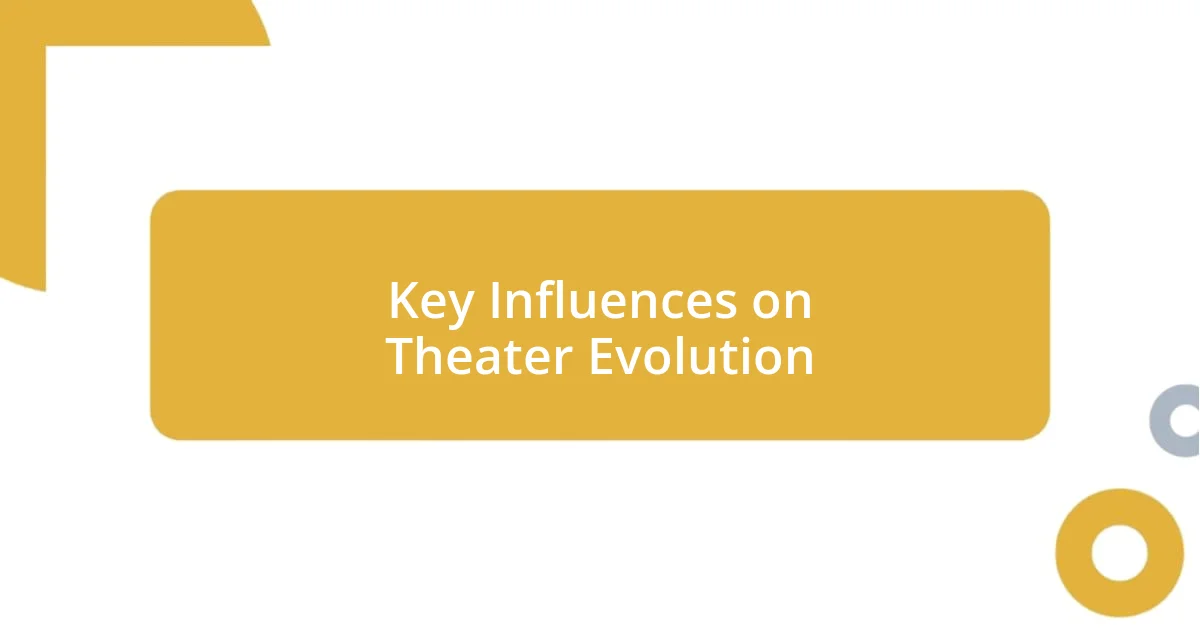
Key Influences on Theater Evolution
The evolution of theater has been significantly influenced by cultural shifts and historical events. I recall my visit to a local theater during a community festival that highlighted indigenous storytelling. It was captivating to see how the narratives reflected the community’s values and struggles, showcasing the vital role theater plays in expressing culture. This experience made me realize just how much the historical context and societal values shape the stories we tell on stage.
Another key influence is technological advancement. When I attended a modern production that beautifully integrated digital projections, I felt as though the boundaries of storytelling were being pushed. The seamless blending of live performances with technology opened my eyes to new possibilities, reminding me that theater is a living, breathing art form that evolves alongside society’s innovations. Have you noticed how technology can enhance emotions in a performance?
Finally, the diverse voices contributing to theater’s evolution cannot be overlooked. I remember watching a play written by a playwright from a marginalized community, which offered an extraordinary perspective that I had never considered before. This experience made me think about how vital it is to include a range of voices in the theatrical conversation, enriching our understanding of humanity. After all, the more perspectives we engage with, the broader our appreciation for the theater becomes.
| Influence | Description |
|---|---|
| Cultural Shifts | Reflect societal values and struggles through storytelling. |
| Technological Advancements | Incorporate new tools to enhance the storytelling experience. |
| Diverse Voices | Offer unique perspectives that enrich the theatrical narrative. |
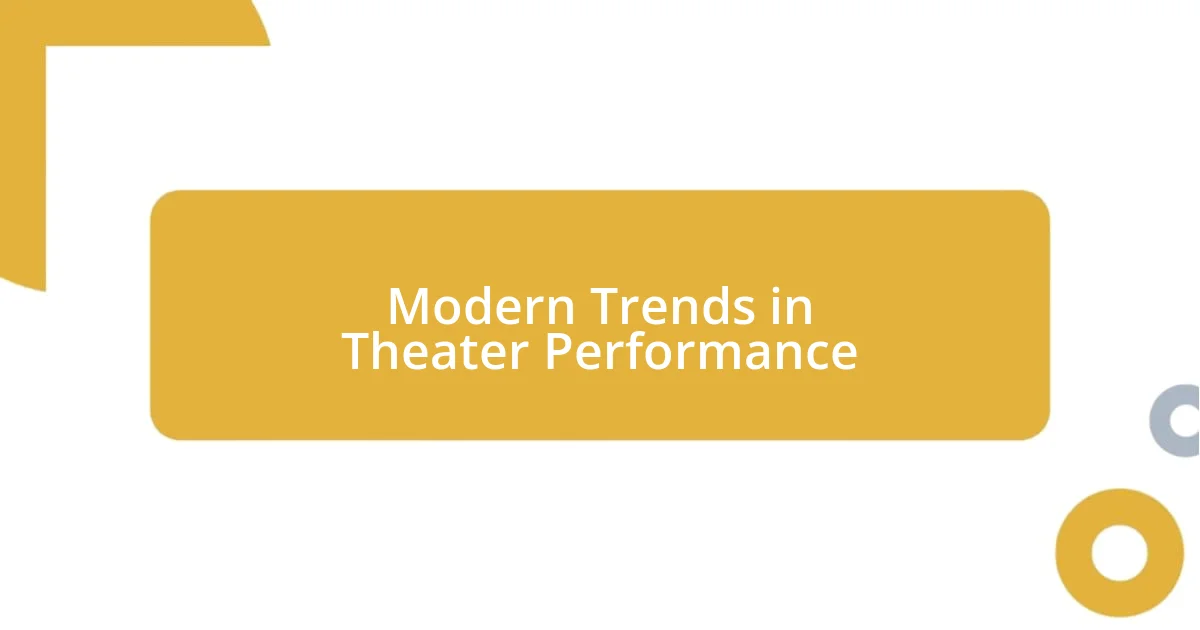
Modern Trends in Theater Performance
The contemporary theater scene is a vibrant tapestry of styles that push the boundaries of traditional performance. I’ve been fortunate enough to attend an immersive theater piece where the audience was encouraged to interact with actors and influence the storyline. It was thrilling! This engagement allows spectators to become part of the narrative, making the performance feel personal and immediate. Have you ever experienced a show where you felt like you were a character in the story? It creates a unique emotional connection that lingers long after the curtain falls.
Another exciting trend I’ve noticed is the integration of multimedia elements, which adds layers of depth to storytelling. At one production, the use of augmented reality transformed the stage into a visually stunning environment that mirrored the emotional highs and lows of the characters. I was captivated by how this fusion of live performance and tech created a more immersive experience. It’s amazing to see how these innovations can elevate the storytelling process, making it resonate on a multitude of sensory levels.
Furthermore, a significant shift in modern theater is the focus on social justice themes. I remember watching a play that tackled serious issues such as systemic racism and climate change. It was powerful how the playwright weaved these complex topics into a narrative that challenged the audience’s perspectives. This commitment to addressing real-world problems through the lens of art speaks volumes about theater’s role in advocating for change. Don’t you think that art should provoke thought and inspire action? That’s what I adore about modern theater—it’s not just about entertainment; it can be a catalyst for discussion and growth.

Techniques for Adapting Styles
Adapting theatrical styles requires a blend of imagination and strategy. One technique I’ve found particularly effective is reinterpreting classic works through modern lenses. For instance, I once participated in a production of Shakespeare that incorporated contemporary dialogue and settings. It transformed how the audience connected with the material, making timeless themes resonate in today’s world—have you experienced a classic piece reimagined in a way that left you pondering its relevance?
Another approach is to reinterpret characters with diverse backgrounds and experiences, which can breathe new life into familiar stories. During a community theater project, I saw firsthand how casting actors from various ethnicities changed the dynamics of a well-known play. Their unique interpretations offered profound insights, making me reflect on the universality of the human experience—as if the performance was actively engaging in a dialogue about identity and belonging.
Finally, I believe that improvisation can be a powerful tool for adapting styles. In a workshop I attended, we experimented with unscripted moments, allowing actors to shape the performance based on their interactions with the audience. It was exhilarating to watch how spontaneous decisions resulted in unexpected, heartfelt responses. Isn’t it fascinating how such an organic method can highlight the essence of theater as an ever-evolving art form?
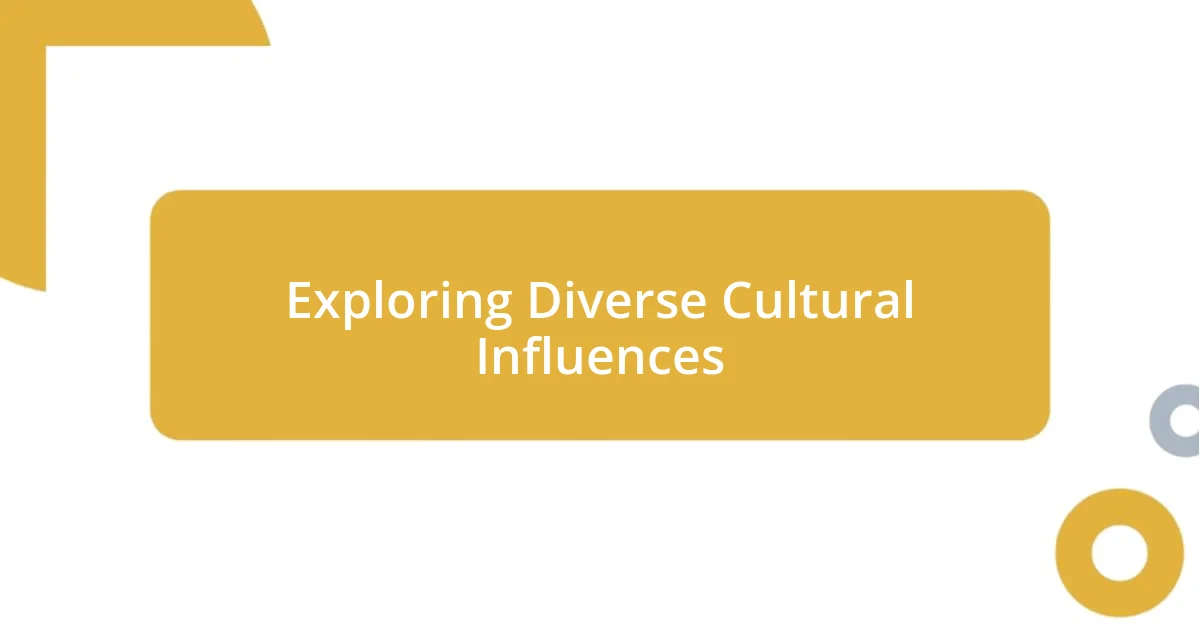
Exploring Diverse Cultural Influences
The world of theater is a beautiful mosaic of cultural influences that enrich our storytelling. I vividly recall a festival where I was introduced to traditional Japanese Noh theater, an art form steeped in history and symbolism. Witnessing the slow, deliberate movements and the dramatic use of masks transported me into a completely different realm of performance. Have you ever encountered a style so distinct that it altered your perception of what theater could be? It’s moments like these that spark appreciation for global traditions and remind us how interconnected we truly are.
As I journeyed through various theatrical styles, I began to see how cultures blend and inspire one another. During a workshop focused on African storytelling through dance and music, I discovered how rhythm can narrate powerful stories that transcend language. The energy in the room was palpable, and I felt a deep sense of connection to the rich heritage being shared. This experience made me reflect on how cultural narratives create a shared space where we can all learn and grow. Wouldn’t you agree that embracing diverse influences only enhances our creative expression?
Additionally, collaborating with artists from different backgrounds has shown me the beauty of cross-cultural storytelling. I remember a project where we fused elements of Indian classical dance with Western contemporary theater. The result was a mesmerizing blend that challenged traditional boundaries and sparked lively conversations about cultural representation. It felt like a dance of ideas, showcasing the joy of collaboration. Isn’t it inspiring to think about the possibilities that arise when we open ourselves to new cultural experiences? Such explorations reveal the rich tapestry of humanity, effortlessly weaving our stories together through theater.
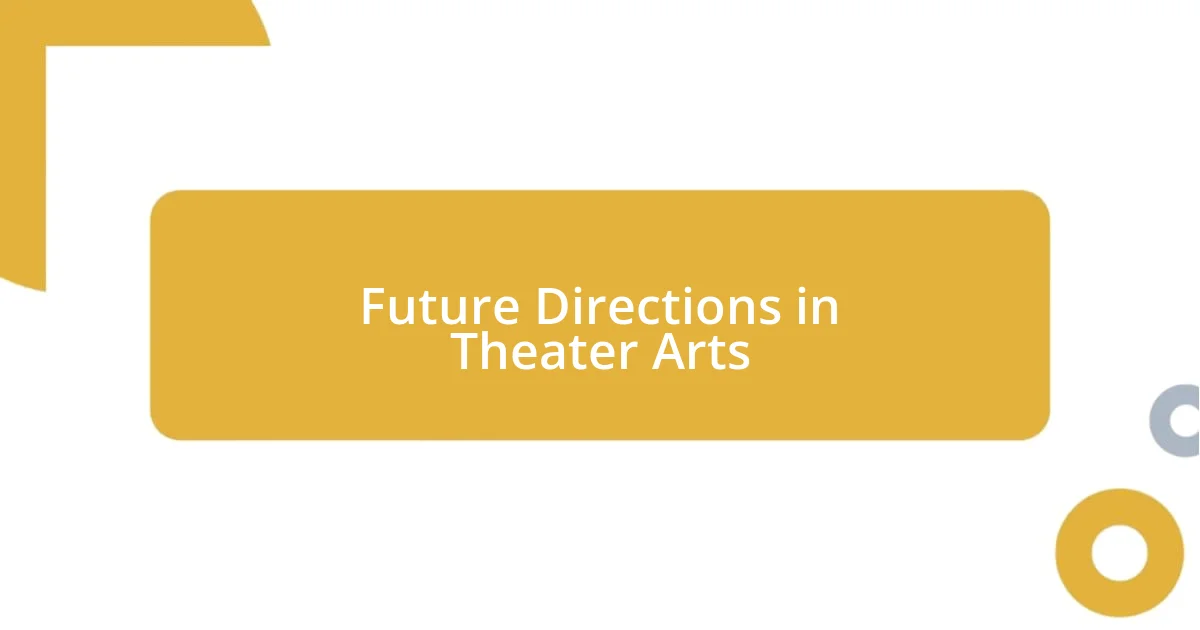
Future Directions in Theater Arts
Thinking about the future of theater arts, I envision a landscape where technology plays an even more integrated role. Recently, I participated in a project that utilized augmented reality, allowing the audience to experience layers of storytelling in ways I had never imagined. This interactive experience not only captivated the viewers but also sparked discussions about how technology can enhance emotional connections—what if the stage became a portal to countless worlds, each accessible at a swipe?
Moreover, I see a growing emphasis on environmental sustainability in theater productions. I was involved in a green initiative where we crafted sets from recycled materials. The challenge of being resourceful brought out creativity in our team, and it felt fulfilling to contribute to a cause larger than ourselves. As we explored ways to minimize our footprint, I couldn’t help but wonder—could our productions inspire other industries to rethink their practices, fostering a culture of sustainability that extends beyond the performing arts?
Lastly, I anticipate a shift towards more immersive and community-centered performances that invite participation beyond traditional audience roles. At a local event, I was amazed by a performance that encouraged audience members to share their stories, turning a scripted play into a communal tapestry of experiences. It was an exhilarating reminder that theater can break the fourth wall, forging deeper connections and reflecting societal issues. Isn’t it exciting to think about how these future directions could redefine our perceptions of art and community?











